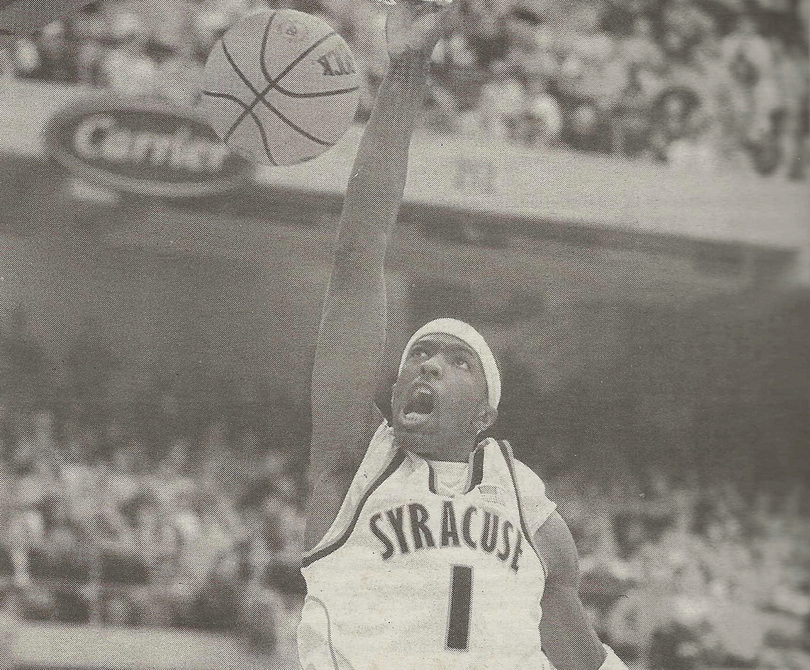HAK ATTACK: Hakim Warrick was known for ‘the block’ in 2003. But he was so much more at Syracuse

Daily Orange Archive Photo
Teammates called Hakim Warrick as “Mr. Go-Go gadget arms.” He used his athleticism to rank top five in points and rebounds for Syracuse all-time.
Get the latest Syracuse news delivered right to your inbox. Subscribe to our sports newsletter here.
B
efore Hakim Warrick electrified Syracuse’s offense with tomahawks from outside the paint, he challenged himself to do it from behind the free-throw line.
In the summer of 2001, prior to Warrick’s freshman year, he was unknown, offered a scholarship only after Julius Hodge committed to NC State. But Warrick made an empathic entrance, mimicking Michael Jordan’s dunk package to perfection in Manley Field House months before his Syracuse debut. He easily dunked from the free-throw line, pulling off Jordan’s cradle reverse slam as well.
“I still haven’t seen somebody as athletic as he was,” said Josh Pace, former Syracuse guard and Warrick’s roommate.
Warrick’s athleticism is best remembered from “the block,” which helped solidify Syracuse’s 2003 National Championship win over Kansas. But Warrick’s impact stretched further than that singular play. He led the Orange to a Big East championship his senior year, earning the tournament MVP while winning the conference player of the year award. Now, Warrick’s No. 1 is permanently in the JMA Wireless Dome rafters after SU retired it on Saturday.
Coming into the collegiate game, Warrick had a chip on his shoulder instantly, Pace said. He wanted to show people how good he really was, though he wasn’t given many opportunities as a freshman. But Warrick got better and better, Pace said, doubling his minutes his sophomore season.
Syracuse’s success corresponded with Warrick’s improvements during his sophomore year. Andrew Kouwe said Warrick had the skill to be a great player, but he earned more confidence with another year under his belt. With most teams focused defensively on Carmelo Anthony, Warrick relished opportunities against smaller defenders.
“Carmelo being that kind of alpha dog on that team in terms of scoring ability and everything, I think it helped motivate Hakim and pushed him,” Kouwe said.
When Anthony left SU after the 2002-03 season, Syracuse quickly became Warrick’s team. With championship experience, Warrick was expected to lead the Orange back to the top. Up until that point, Warrick still hadn’t earned the respect he deserved nationally.
Warrick was one of 16 finalists for the 2003 USA Basketball Men’s Pan American Games Team, but he was cut. The team’s head coach, Tom Izzo, brought his Michigan State squad to the Carrier Dome on Jan. 3, 2004.
In an “emotional” game, Warrick dominated. Midway through the second half, Warrick dribbled into the paint, immediately surrounded by two defenders. Calmly, he rose over both and redirected Billy Edelin’s inbounds pass off the glass and into the basket.
Warrick finished with 21 points, close to his team-high average of 19.8 points per game during his junior season. Demetris Nichols, who was a freshman at the time, said Warrick’s biggest strength was his consistency, which started in practice.
“He dominated practice, so he dominated the games,” Nichols said.

Arlo Stone | Design Editor
Every night, Warrick’s teammates and coaches expected him to score close to 20-plus points. The majority of the time, that was the reality. He set an example for Nichols, who would be in the same position a few years later.
“He was going to get his numbers and do his job,” Nichols said. “He gave me the blueprint of what you’re supposed to do when you’re a leader of a team at Syracuse.”
Head coach Jim Boeheim was tough on Warrick, Nichols said, but Warrick’s preparation helped him live up to the high standards Boeheim had for all of his forwards.
“Preparation takes away the pressure because if you know that you’re prepared, you know you have the best chance to be successful,” Nichols said.
Warrick was most prepared for games against big opponents, bringing his game to another level whenever Georgetown, UConn or any ranked school visited the Dome. He ignited the stadium with his high-flying dunking, helping the Orange string together multiple runs to control a game.
“It was a big momentum boost whenever he got a big dunk,” Kouwe said.
In South Bend, Indiana, during his senior season, Warrick received the ball at the left block three minutes into the game. He backed Notre Dame’s Dennis Latimore down before retreating back, his right heel outside of the paint.
Warrick could have easily laid the ball into the basket. But he had the length and confidence to jump over Latimore and slam in two points. Latimore didn’t even put a hand up and Syracuse went on to win the game 70-61.

Hakim Warrick watches his jersey get retired in the JMA Wireless Dome alongside his family. Meghan Hendricks | Photo Editor
“Throughout his career, he was able to use that athleticism to his advantage where it wasn’t a classic high dunk,” Kouwe said.
Warrick’s athleticism is immortalized by a play he made on the other end of the floor. Kouwe was on the bench during “the block,” and Warrick was invisible at first.
Michael Lee appeared to have enough space to settle for an uncontested 3 in the left corner until Warrick rotated just in time, leapt forward and swatted the ball out of bounds.
“You’re looking at that ‘wow, Lee is wide open in the corner,’ and then here comes Mr. Go-Go gadget arms and just takes care of it,” Kouwe said.
After the game, those “go-go gadget arms” raised Syracuse’s first and only national championship. On Saturday, Warrick extended his No. 1 jersey into the air, forever etched in Syracuse history.
“You think of some of the great all-time Syracuse players, Hakim just puts himself right there with those guys and having that national championship and that iconic play is pretty special,” Kouwe said.




